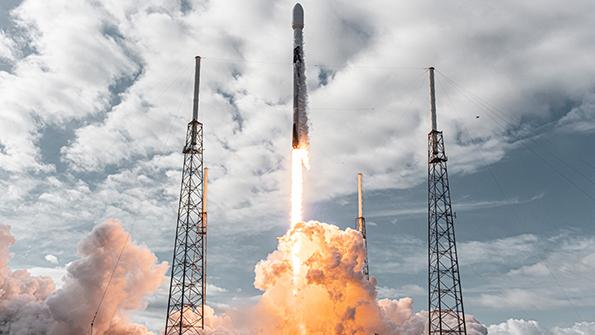
SpaceX broke another world record in January by launching the largest number of satellites ever flown on a single rocket: 143 of them on its Transporter-1 mission.
In that process, SpaceX also kick-started its so-called ride-share program targeted at smallsats—satellites with a mass below 200 kg (440 lb.)—the smallest of which, cubesats, can be as light as a few kilograms. With an entry-level fixed price of $1 million for up to 200 kg of satellite mass, this program has the potential to set the cats among the pigeons in this nascent smallsat industry and trigger another wave of “new space” innovation.
Historically, launch prices have been driven primarily by the mass of satellites, and the standard measuring unit has been dollars per kilogram. Today, the average market price to launch a cubesat (typically 1-20 kg in mass) into low Earth orbit is around $30,000 per kilogram on a dedicated launcher. This implies that to launch a 12U (20-kg) cubesat, one should expect to pay about $600,000. But with SpaceX’s ride-share program, 10 times as much mass (200 kg) can theoretically be launched for a price only 60% higher.
This, however, does not represent the full cost of sending a satellite into orbit. In that respect, SpaceX’s ride-share launcher is like a passenger airplane: It can take a lot of passengers (satellites) to a specific location, but once there, these passengers need to find another means of transportation to reach their final destination. In the case of smallsats, they will need to use either a transfer vehicle or an onboard propulsion system for their “last-mile delivery.” This will of course add costs, which ultimately will reduce the price differential between a ride-sharing and a dedicated launch.
What this all means is that, suddenly, the “price-mass” equation for smallsat launches has become much more complex. Although a dedicated launcher is the most expensive option, it will take the satellite straight to its final destination, saving time, mass (no need for a transfer vehicle or a propulsion system) and therefore money. On the other hand, using a transfer vehicle or onboard propulsion from a low-cost ride-sharing launcher—like taking a taxi or a private car from the airport—will add extra cost and time (up to several months).
Additionally, the ride-sharing model raises new questions relevant to the design of the satellites themselves. For example, is it worth (re-)designing a platform to accommodate an embedded propulsion system to fully benefit from a ride-share? And how much complexity does the use of a transfer vehicle add to the mission?
Therefore, the economics of smallsats are likely to change drastically, and miniaturization for the sake of saving mass and thus launch costs may not be a predominant driver anymore. Indeed, if it is possible to launch a 200-kg minisatellite for almost the same price as a 20-kg cubesat, then the value of miniaturization and thus the rationale for using cubesats in the first place may fade away. Bigger satellites might become not only cheaper to launch but also to design (due to fewer physical space constraints and a more modular architecture) and even to produce. Some analyses show that a minisatellite will not be much more expensive to mass-produce than a cubesat because economies of scale are not materially different whether one produces 100 or 1,000 units per year (assuming one needs 10 times more cubesats than minisatellites to do the same job).
Furthermore, the architecture of cubesats makes it more difficult to decouple the platform and its payload (because of the increased compactness and hyperintegration) and therefore involves relatively high and incompressible nonrecurring costs. Finally, as many customers start requiring more bandwidth, more power, more maneuverability and longer service life, it will become harder for cubesats to compete with micro- or minisatellites. As a matter of fact, several smallsat manufacturers are now migrating from cubesats toward platforms in the 50-100-kg range.
SpaceX’s ride-share program thus raises fundamental questions about the viability of the cubesat format, in particular for large-scale commercial applications (e.g., constellations). More generally, it challenges the existing economics of smallsat missions and brings back into focus the strategic issue of access to space in all its forms (dedicated launcher, ride-share, last-mile delivery). This issue, combined with that of space debris and the risks of collision in space, certainly explains the current frenzy of startups and investment around the “in-space propulsion” segment. Be ready for another wave of “new space” innovation.
The views expressed are not necessarily those of Aviation Week.






Comments
Also, some large constellations will still prefer cubesats launched from larger, dedicated dispensers which also act as transfer vehicles.
One size most definitely does not fit all.